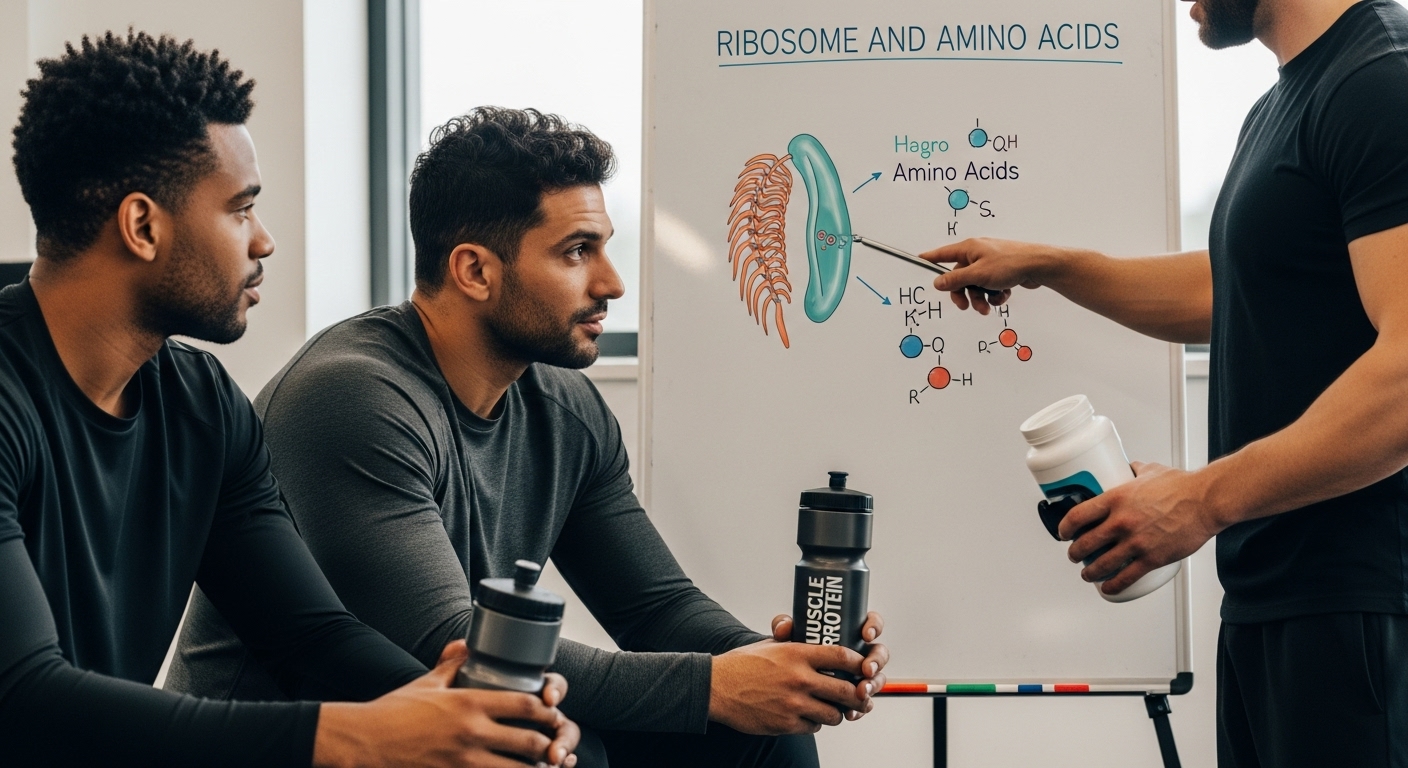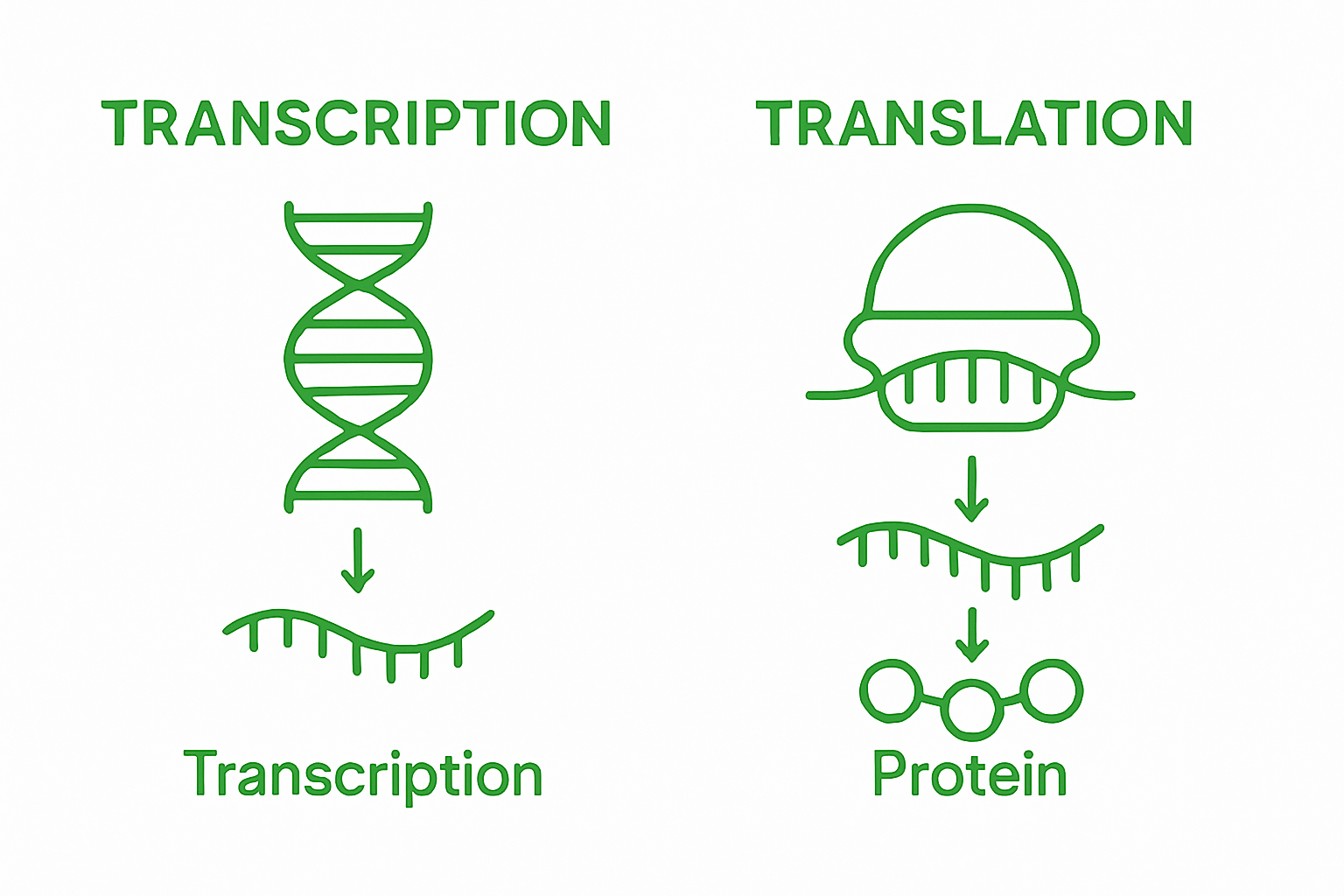Protein synthesis sounds like something out of a science textbook and yet it is happening in your body every moment without you even noticing. Believe it or not scientists have found that the efficiency of this process is what allows muscles to grow and heal, making it deeply relevant whether you are an athlete or not. Strangely enough, the most fascinating part is that the sequence of amino acids alone determines a protein’s entire shape and function, meaning every tiny change ripples across your biology in ways you cannot imagine.
Table of Contents
- What Is Protein Synthesis And Its Role In The Body?
- The Importance Of Protein Synthesis For Bodybuilders And Athletes
- How Protein Synthesis Works: A Look At The Process
- Key Concepts In Protein Synthesis: Amino Acids And Ribosomes
- Real-World Applications Of Protein Synthesis In Nutrition And Fitness
Quick Summary
| Takeaway | Explanation |
|---|---|
| Protein synthesis occurs in two stages: transcription and translation | Genetic information is first copied into mRNA, then translated into proteins by ribosomes. |
| Optimal protein intake enhances muscle recovery and growth | Consuming high-quality proteins post-exercise supports muscle rebuilding and accelerates growth. |
| Timing protein consumption is crucial for athletes | Distributing protein intake throughout the day maximises amino acid availability for muscle repair. |
| Amino acids are essential building blocks of proteins | The sequence and arrangement of amino acids determine the final protein shape and function. |
| Ribosomes are vital for protein assembly | These cellular machines read mRNA and link amino acids to create functional proteins. |
What is Protein Synthesis and Its Role in the Body?
Protein synthesis represents a fundamental biological process that enables living organisms to create new proteins essential for cellular function and survival. According to research from the National Center for Biotechnology Information, this intricate molecular mechanism occurs continuously within cells, serving as the primary method for generating functional proteins that drive numerous physiological activities.
The Molecular Blueprint of Protein Creation
At its core, protein synthesis involves two critical stages: transcription and translation. During transcription, genetic information stored in DNA is copied into messenger RNA (mRNA), creating a portable genetic blueprint. This mRNA then serves as a template during translation, where cellular machinery called ribosomes read the genetic instructions and assemble amino acids into specific protein structures.
Key Elements of Protein Synthesis:
- DNA provides the original genetic code
- mRNA acts as the messenger carrying instructions
- Ribosomes function as protein assembly machines
- Transfer RNA (tRNA) brings specific amino acids to the ribosome
Biological Significance of Protein Production
Proteins are not merely structural components but dynamic molecules performing countless functions within biological systems. They serve as enzymes facilitating chemical reactions, hormones regulating bodily processes, antibodies defending against infections, and structural elements maintaining cellular integrity.
For fitness enthusiasts and athletes, understanding protein synthesis becomes particularly crucial. Learn more about muscle protein synthesis in our comprehensive guide, which explores how nutritional strategies and exercise can optimise protein production for muscle growth and recovery.
The precision and efficiency of protein synthesis determine an organism’s ability to adapt, repair tissues, respond to environmental challenges, and maintain overall physiological balance. From supporting immune function to enabling cellular communication, proteins synthesised through this remarkable process underpin life itself.
The following table summarises the main roles and functions of proteins in the human body as described in the article, helping readers quickly distinguish their importance across biological systems.
| Protein Function | Description | Examples |
|---|---|---|
| Enzymatic | Catalyse chemical reactions in the body | Digestive enzymes |
| Structural | Provide support and maintain cellular integrity | Collagen, keratin |
| Hormonal | Regulate physiological processes | Insulin, growth hormone |
| Immune Defence | Protect against infections and disease | Antibodies |
| Transport | Carry molecules throughout the body | Haemoglobin, albumin |
| Muscle Maintenance | Repair and build muscle tissues | Actin, myosin |
The Importance of Protein Synthesis for Bodybuilders and Athletes
Research from sports nutrition experts demonstrates that protein synthesis is a critical physiological process for athletes and bodybuilders seeking optimal muscle growth, recovery, and performance. Understanding how this complex biological mechanism operates can unlock significant improvements in training outcomes and physical development.
Muscle Growth and Repair Mechanisms
Protein synthesis plays a fundamental role in muscle hypertrophy and recovery. When muscles experience mechanical stress during resistance training, they trigger a cellular response that increases protein production. This process allows muscle fibres to repair microscopic damage, become stronger, and increase in size. Intense physical activity fundamentally stimulates protein synthesis, creating an anabolic environment where muscle tissue can regenerate and expand.
Key Performance Impacts of Protein Synthesis:
- Enables muscle tissue repair after intense workouts
- Supports muscle protein accretion and hypertrophy
- Facilitates faster recovery between training sessions
- Helps maintain muscle mass during periods of dietary restriction
Nutritional Strategies for Optimising Protein Production
Athletes can strategically enhance protein synthesis through targeted nutritional interventions. Consuming high-quality protein sources with complete amino acid profiles immediately after training can significantly accelerate muscle recovery and growth. Explore our comprehensive guide on high protein diets to understand how dietary choices directly influence muscle protein synthesis.
Precise protein intake timing, coupled with adequate leucine consumption, can create an optimal physiological environment for muscle protein synthesis. Consuming approximately 20-30 grams of protein per meal, spread across multiple servings throughout the day, ensures consistent amino acid availability for muscle rebuilding and growth.

How Protein Synthesis Works: A Look at the Process
According to molecular biology research, protein synthesis represents an intricate molecular dance involving multiple cellular components working in precise coordination to transform genetic information into functional proteins. This complex biological process occurs within every living cell, serving as the fundamental mechanism for translating genetic instructions into tangible biological machinery.
Transcription: The Genetic Blueprint Generation
Transcription marks the initial stage of protein synthesis, where genetic information encoded in DNA is carefully copied into messenger RNA (mRNA). During this phase, specialised enzymes called RNA polymerases unwind the DNA double helix, creating a complementary mRNA strand that carries the precise genetic instructions from the nucleus to the cellular protein manufacturing sites.
Critical Components of Transcription:
- DNA serves as the original genetic template
- RNA polymerase facilitates genetic information copying
- mRNA carries genetic instructions from nucleus to cytoplasm
- Specific nucleotide sequences determine protein characteristics
Translation: Protein Assembly and Formation
Translation represents the second critical stage where mRNA instructions are converted into actual protein structures. Ribosomes act as molecular factories, reading the mRNA sequence and systematically linking amino acids in the exact order specified by genetic instructions. Learn more about protein structures in our guide to peptide proteins.
During translation, transfer RNA (tRNA) molecules play a crucial role by delivering specific amino acids to the ribosome, ensuring each protein is constructed with precision. The entire process resembles a highly orchestrated molecular assembly line, where genetic information is transformed into functional biological tools that drive cellular processes.
Here is a table that breaks down the main stages and core actors involved in protein synthesis, providing a clear visual overview of the process described in the article.
| Stage | Main Actors | Description |
|---|---|---|
| Transcription | DNA, RNA polymerase, mRNA | DNA is copied into mRNA by RNA polymerase in the nucleus. |
| mRNA Processing | mRNA | mRNA undergoes modifications and exits the nucleus into the cytoplasm. |
| Translation | mRNA, ribosomes, tRNA, amino acids | Ribosomes read the mRNA, and tRNA delivers specific amino acids to assemble proteins. |
| Protein Folding | Protein molecules | Newly formed proteins fold into specific shapes to perform biological functions. |
Key Concepts in Protein Synthesis: Amino Acids and Ribosomes
Biochemical research reveals that amino acids and ribosomes are fundamental components driving the intricate process of protein synthesis. These molecular building blocks work in extraordinary synergy to transform genetic instructions into functional proteins essential for cellular operations.
The Essential Role of Amino Acids
Amino acids represent the fundamental structural units of proteins, functioning like molecular letters that combine to form complex protein sentences. Each amino acid contains a unique chemical structure with an amino group, a carboxyl group, and a distinctive side chain that determines its specific properties. The sequence and arrangement of these amino acids dictate the protein’s ultimate shape and function.
Characteristics of Amino Acids:
- Serve as primary protein building blocks
- Contain unique chemical structures
- Determine protein functionality through specific sequences
- Interact with each other through peptide bonds
Ribosomes: Molecular Protein Factories
Ribosomes function as sophisticated cellular machines responsible for protein assembly. These complex structures comprise RNA and proteins, operating like molecular factories that read genetic instructions and systematically link amino acids together. Discover more about protein structures in our comprehensive peptide protein guide.
During protein synthesis, ribosomes move along messenger RNA, decoding genetic information and facilitating precise amino acid connections. This remarkable process ensures each protein is constructed with exceptional accuracy, transforming genetic blueprints into functional biological molecules that drive cellular processes.

Real-World Applications of Protein Synthesis in Nutrition and Fitness
Sports nutrition research demonstrates that understanding protein synthesis provides critical insights into muscle development, recovery, and overall athletic performance. By comprehending how protein production occurs at a cellular level, athletes and fitness enthusiasts can optimise their nutritional strategies and training approaches.
Muscle Growth and Recovery Mechanisms
Protein synthesis plays a pivotal role in muscle hypertrophy and tissue repair. When muscles undergo mechanical stress during resistance training, cellular protein production mechanisms activate, enabling muscle fibres to rebuild and grow stronger. The rate of muscle protein synthesis directly correlates with muscle adaptation and growth potential, making it a fundamental process for athletes seeking performance improvements.
Key Nutritional Considerations for Protein Synthesis:
- Consuming adequate protein quantity and quality
- Timing protein intake around training sessions
- Balancing macronutrient intake for optimal protein utilisation
- Supporting protein synthesis with essential amino acids
Nutritional Strategies for Enhancing Protein Production
Athletes can strategically influence protein synthesis through targeted nutritional interventions. Consuming high-quality protein sources with complete amino acid profiles immediately post-exercise can accelerate muscle recovery and growth. Learn more about protein isolates and their specific benefits to understand how different protein types impact cellular protein production.
Optimal protein synthesis requires a holistic approach combining precise nutritional intake, appropriate training stimulus, and sufficient recovery periods. By understanding these interconnected mechanisms, individuals can develop more effective strategies for muscle development and overall athletic performance.
Unlock Your Full Muscle-Building Potential with Nutrition Backed by Science
You have learned that protein synthesis is the engine behind muscle growth, repair, and performance. Yet, many athletes and fitness enthusiasts struggle to see consistent progress. This often happens because daily nutrition does not deliver the exact ingredients your body requires for efficient protein production. If you want every rep and set to count, high-quality supplements are the key to transforming your training into visible results.

Take the next step towards powerful gains by exploring our curated range at MyGymSupplements.shop. We stock advanced proteins, amino acids, and recovery solutions to support muscle protein synthesis at every stage. Do not let your hard work go to waste. Visit MyGymSupplements.shop today and discover how our expertly selected products can help you accelerate muscle recovery and growth. For focused insights on high protein diets and their impact, read our comprehensive high protein diet guide and start optimising your results now.
Frequently Asked Questions
What is protein synthesis?
Protein synthesis is the biological process through which cells create new proteins by translating genetic information from DNA into functional proteins. It involves two main stages: transcription, where DNA is transcribed into messenger RNA (mRNA), and translation, where ribosomes read the mRNA to assemble amino acids into proteins.
Why is protein synthesis important for athletes?
Protein synthesis is crucial for athletes because it facilitates muscle growth, repair, and recovery after workouts. It helps rebuild muscle fibres that are damaged during exercise, allowing for increased strength and size, and aids in faster recovery between training sessions.
How can nutrition influence protein synthesis?
Nutrition significantly influences protein synthesis. Consuming high-quality protein sources immediately after exercise can enhance muscle recovery and promote growth. Adequate intake of essential amino acids, especially leucine, is also vital for optimising protein production in the body.
What are the main steps involved in protein synthesis?
The main steps of protein synthesis include transcription, where DNA is copied into mRNA, and translation, where ribosomes read the mRNA sequence and use transfer RNA (tRNA) to assemble the corresponding amino acids into a growing protein chain.



0 comments